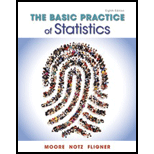
Concept explainers
To identify: The distribution.
Answer to Problem 14.13CYS
The correct option is (b)
Explanation of Solution
Reason for the correct answer:
The random variable x represents the number of contaminated eggs. Here, the random sample 3 (n) eggs have been randomly selected. Moreover, given that one out of four eggs
Also, there are two possible outcomes (choosing the contaminated eggs and non-contaminated eggs) with the
Reason for the incorrect answers:
Option (a) binomial with
Here, Larry does not use more than 3 eggs for cooking and he chose only one out of four eggs containing the salmonella bacteria.
Here, the number of eggs chosen randomly is not 4.
Option (c) binomial with
Here, Larry does not use more than 3 eggs for cooking and he chose only one out of four eggs containing the salmonella bacteria.
Here, one out of three eggs is chosen at random. Thus,
Thus, the Options (a) and (c) are incorrect.
Conclusion:
Therefore, Larry uses three eggs chosen at random and that has the distribution binomial with
Introduction:
Binomial distribution:
The random variable x is defined as the number of success observations that follows the binomial distribution if the distribution has fixed number of observations (n) in which all the observations are independent and have two possible outcomes (success and failure). Also, for each observation, p represents the probability of successes.
The probability using binomial distribution is given by,
Where, n is the number of trials, x is the number of successes among n trials, p is the probability of successes and q is the probability of failures.
Want to see more full solutions like this?
Chapter 14 Solutions
The Basic Practice of Statistics
 MATLAB: An Introduction with ApplicationsStatisticsISBN:9781119256830Author:Amos GilatPublisher:John Wiley & Sons Inc
MATLAB: An Introduction with ApplicationsStatisticsISBN:9781119256830Author:Amos GilatPublisher:John Wiley & Sons Inc Probability and Statistics for Engineering and th...StatisticsISBN:9781305251809Author:Jay L. DevorePublisher:Cengage Learning
Probability and Statistics for Engineering and th...StatisticsISBN:9781305251809Author:Jay L. DevorePublisher:Cengage Learning Statistics for The Behavioral Sciences (MindTap C...StatisticsISBN:9781305504912Author:Frederick J Gravetter, Larry B. WallnauPublisher:Cengage Learning
Statistics for The Behavioral Sciences (MindTap C...StatisticsISBN:9781305504912Author:Frederick J Gravetter, Larry B. WallnauPublisher:Cengage Learning Elementary Statistics: Picturing the World (7th E...StatisticsISBN:9780134683416Author:Ron Larson, Betsy FarberPublisher:PEARSON
Elementary Statistics: Picturing the World (7th E...StatisticsISBN:9780134683416Author:Ron Larson, Betsy FarberPublisher:PEARSON The Basic Practice of StatisticsStatisticsISBN:9781319042578Author:David S. Moore, William I. Notz, Michael A. FlignerPublisher:W. H. Freeman
The Basic Practice of StatisticsStatisticsISBN:9781319042578Author:David S. Moore, William I. Notz, Michael A. FlignerPublisher:W. H. Freeman Introduction to the Practice of StatisticsStatisticsISBN:9781319013387Author:David S. Moore, George P. McCabe, Bruce A. CraigPublisher:W. H. Freeman
Introduction to the Practice of StatisticsStatisticsISBN:9781319013387Author:David S. Moore, George P. McCabe, Bruce A. CraigPublisher:W. H. Freeman





